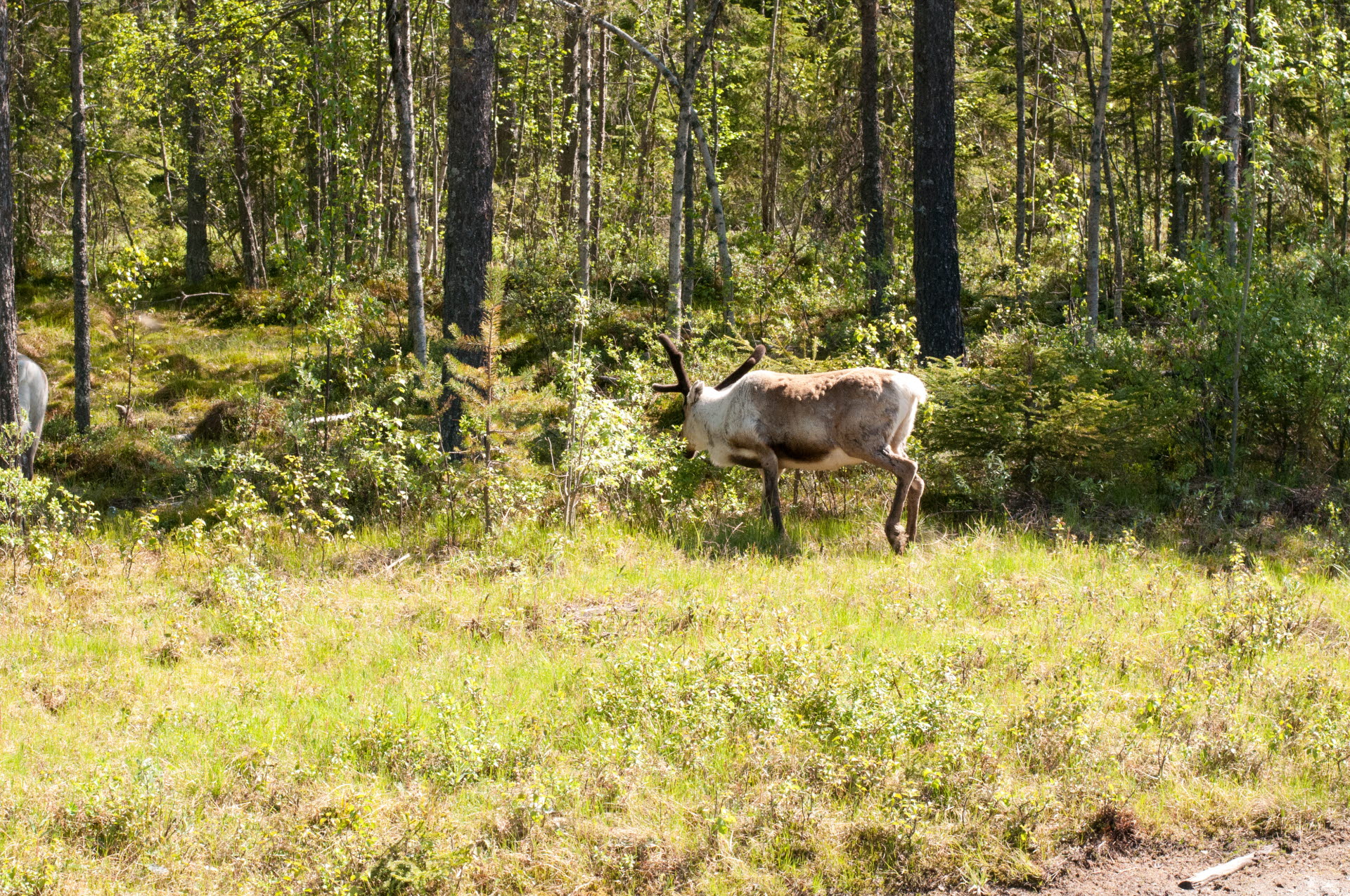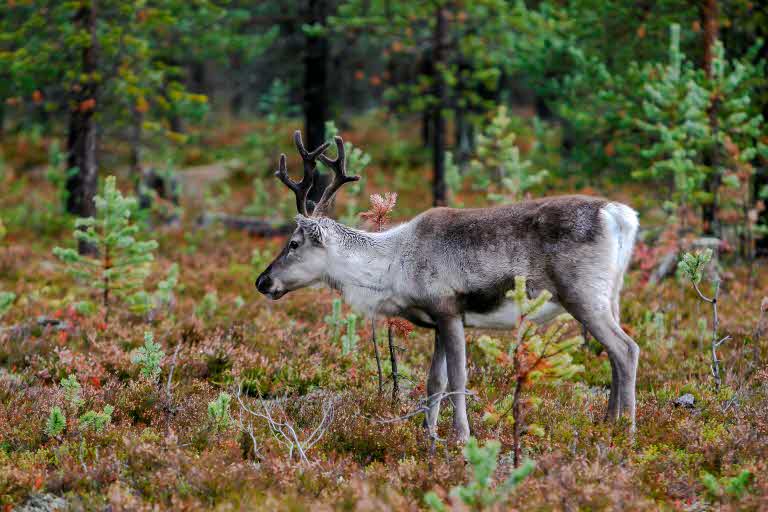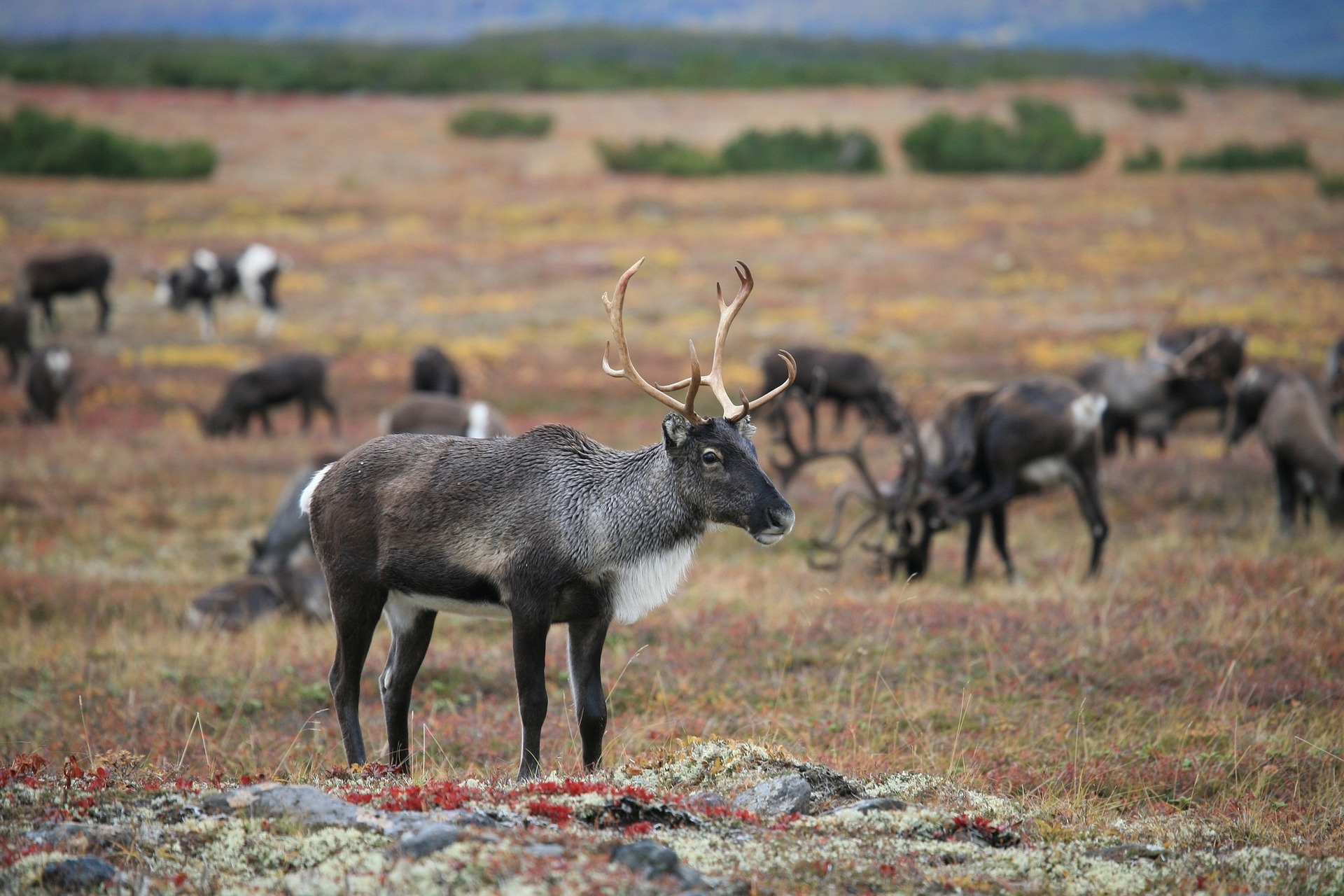
- FOREST
- SCA's FORESTS
- RESPONSIBLE FORESTRY
- CONSIDERATION FOR THE REINDEER HUSBANDRY
Consideration for the reindeer husbandry
The Sami communities own the right to reindeer herding on SCA's land. It is important with a good cooperation between the Sami communities and SCA, so we both can continue with our businesses.

There are 51 Sami communities in Sweden, from Norrbotten in the north to Dalarna in the south. These communities have approximately 2,500 members with herding rights. Some ten to twenty times more Swedes have Sami origins, but are not members of any Sami community. The Sami communities are legal entities with reindeer herding rights in the community's area. Sometimes, several communities will overlap.
A Sami community normally encompasses summer pasture land in or near the mountains and winter pasture land down in the forest — in many cases all the way down to the coast. The reindeer have a natural yearly cycle, moving between summer and winter grazing. They are moved between these areas, either driven by reindeer herders or using animal transport trucks.
The Reindeer Husbandry Act
Reindeer herding is a right to the use of someone else's land. The Sami communities thus own the right to reindeer herding on SCA's and other owners' land. Reindeer herding is regulated by the Swedish Reindeer Husbandry Act. It regulates such issues as how many reindeer the Sami communities can keep, and the requirements for the consideration of reindeer herding that forest owners are obliged to take. In the summer pasture lands, forest owners are obliged to consult with the Sami communities regarding forestry measures, whereas in the winter pasture lands this is voluntary.
The Sami communities also have the right to consultation regarding other operations that impact reindeer herding such as wind power, mines and infrastructure projects.
Forestry and reindeer herding
During the summer, reindeer graze on moss and plants, often in the mountain districts where no forestry operations are pursued. During the winter, the reindeer live on ground moss and tree moss. The reindeer scrape out ground moss from under the snow, but under severe winter conditions they depend on tree moss.
Forestry impacts the occurrence of both ground and tree moss. When trees are harvested, tree moss disappears as well, only returning when the new stock has matured. Site preparation — which tears up moss to a greater or lesser extent, depending on the method — most often follows harvesting. When a harvested area is planted, the young stands are often so compact that the ground mosses are pushed back. They spread out again after the stock undergoes cleaning and pre-commercial thinning. Fertilization makes the ground more hospitable to grass and plants, which spread out at the expense of the mosses.
Forestry also impacts the mobility of both reindeer and herders. Dense young forest can make it difficult for reindeer herders on snowmobiles to drive their herds in one direction and can require them to resort to the more expensive method of herding by helicopter. An improperly laid forest road can tempt the reindeer into going in an inconvenient direction. In winter, ploughing of roads can be a measure that impacts reindeer herding. The reindeer choose to follow the ploughed road and can end up in unsuitable situations.
Finally, forestry can impact relics of Sami history such as old camping or cult sites.
What impact do various forestry methods have?
Here are som examples:
- Final harvesting is the most thorough step in forestry. It means that the trees disappear, and that conditions on the site will be changed for decades after the harvesting. Harvesting of trees with large amounts of reindeer moss is a particularly important issue for reindeer herding.
- Site preparation and selection of site preparation method impact access to ground moss.
- The choice of wood impacts the occurrence of ground moss. Often, the choice is between planting pine or contorta pine on land where moss is found. Contorta pine grows 40% faster than Swedish pine. It therefore forms compact stock more rapidly, which provides shade, pushes back ground mosses and can be so compact that it makes driving reindeer in the desired direction harder for the herders. Dense forests can also hide predators.
- Thinning is often a step in forestry that is seen as positive by reindeer herding. It makes the forest more open, thereby facilitating movement for both reindeer and herders. Often the presence of ground mosses increases after thinning.
- Fertilization makes the ground more hospitable for plant life, putting ground mosses at a disadvantage.
- Road construction impacts reindeer movement patterns, as does ploughing of forest roads.
SCA's consideration for reindeer herding

SCA owns forests or pursues forestry in 49 Sami communities and we have a participatory planning process with 34 Sami communities.
SCA puts great care and a large amount of resources into consultation with the Sami communities and we have 16 silviculture managers that handles all planning processes together with a central expert. During a year we put approximately time comparable to one to two full time jobs to the planning processes. All SCA employees have all been trained in reindeer herding and in the needs and priorities of reindeer husbandry. SCA has also offered the Sami communities training in forestry.
The planning process often takes place during winter, where we and the Sami representatives discuss what kind of measure we can do to facilitate their business. If both parts are unsure what it looks like in a special place, we arrange for a field visit and together we visit the place.
One important question for Sami communities is planting contorta pine. The contorta pine has a high growth rate and forms dense forest that can cause problems for reindeer herding. All planting by SCA in reindeer herding areas are preceded by consultations with affected Sami communities. Approximately 15% of the company’s forest is made up of contorta pine and measures required in existing stands to facilitate reindeer herding are also handled through consultations.
The considerations include:
- Final harvesting: harvesting is postponed, final harvesting is replaced with some form of selective harvesting, trees and tree groups with a large amount of hanging moss are saved
- Site preparation: site preparation methods that impact a smaller portion of the land
- Choice of tree species: a choice that yields less impact on reindeer herding
- Clearing: forests that are thinned out are more favourable for the lichen on the ground that the reindeers eats since a closed forest prevents its growth. Cleared forest are also easier to move around in, for both reindeers and humans.
- Fertilization: avoid areas that are important for reindeer herding, above all areas with large amounts of ground moss
- Road construction: choice of route and where raw materials for road construction are to be picked up
- Snowploughing: avoid ploughing in areas and times that disrupt reindeer herding
- Where mistakes have been made, SCA has sought to make things right, for example, by pulling up contorta seedlings on land where they disrupted reindeer herding. Thinning has been planned and brought forward to facilitate reindeer herding.
Some of the things valued most highly by the Sami communities in contact with SCA is having a contact person with good local knowledge, who knows and understands the needs of reindeer herding and has a mandate to take decisions.

SCA, FSC and reindeer herding
According to the principles and criteria of the Forest Stewardship Council® (FSC®), consideration of the rights of indigenous peoples is a tremendously important part of conducting responsible forestry. Since SCA’s forestry is certified according to FSC we take a greater responsibility than that the Reindeer Husbandry Act specify.
Under the Reindeer Husbandry Act, forest owners are only obliged to consult with Sami communities on forestry measures in summer pasture lands. But in the Swedish FSC standard currently in force, a forest owner must consult in the same way in winter pasture lands as well. This mean that we have consultations for all forestry measures for all pasture lands.
The FSC standard, which was applied in autumn 2020, provides a special collaborative process, which offers reindeer herders greater influence over planned forestry measures. Joint planning is based on the principle of Free Prior and Informed Consent (FPIC) of indigenous peoples, and aims to enable forest operations and reindeer herding to coexist in the forest landscape. Both forest owners and reindeer herders must clearly present long-term needs and plans, and then forestry and reindeer herding must be jointly planned over longer periods of time and over larger areas. This is to enable coexistence between forest operations and reindeer herding in the forest landscape. There are also new rules for handling situations where agreement is not possible in local consultation.
Other problems for reindeer herding
- Reindeer herding is also impacted by land use other than forestry. For example:
- The water power expansions from the 1950s and 1960s have radically changed access to land and the migratory paths for many Sami communities. Regulation of the water supply can also make it difficult to drive the reindeer along the rivers between winter and summer pastures.
- Mining operations impact reindeer herding. Currently, there are some ten permit cases before the Swedish Government concerning mines in reindeer herding areas.
- The reindeer industry believes that wind power entails a major negative impact on reindeer herding, and that the reindeer try to avoid going near wind turbines. Wind power expansion also entails extensive road construction on wind farms.
- All types of road construction and other infrastructure can impact reindeer movement patterns, both during and after the construction period.
- Tourism negatively impacts reindeer husbandry. Increasing numbers of people moving around reindeer disturbs them and causes stress, forcing them to flee in unsuitable directions.
- Growing numbers of predators are a major problem for reindeer husbandry. Bears, lynx, wolverines, golden eagles and above all wolves can all hunt down reindeer or calves, and can cause even more extensive damage by splitting herds.
- One result of climate change is that the tree line is moving upwards into the mountains. Periods of extreme weather are becoming more common — for example, winter thaws that lead to the formation of ice crusts that make it impossible for the reindeer to get at ground moss.